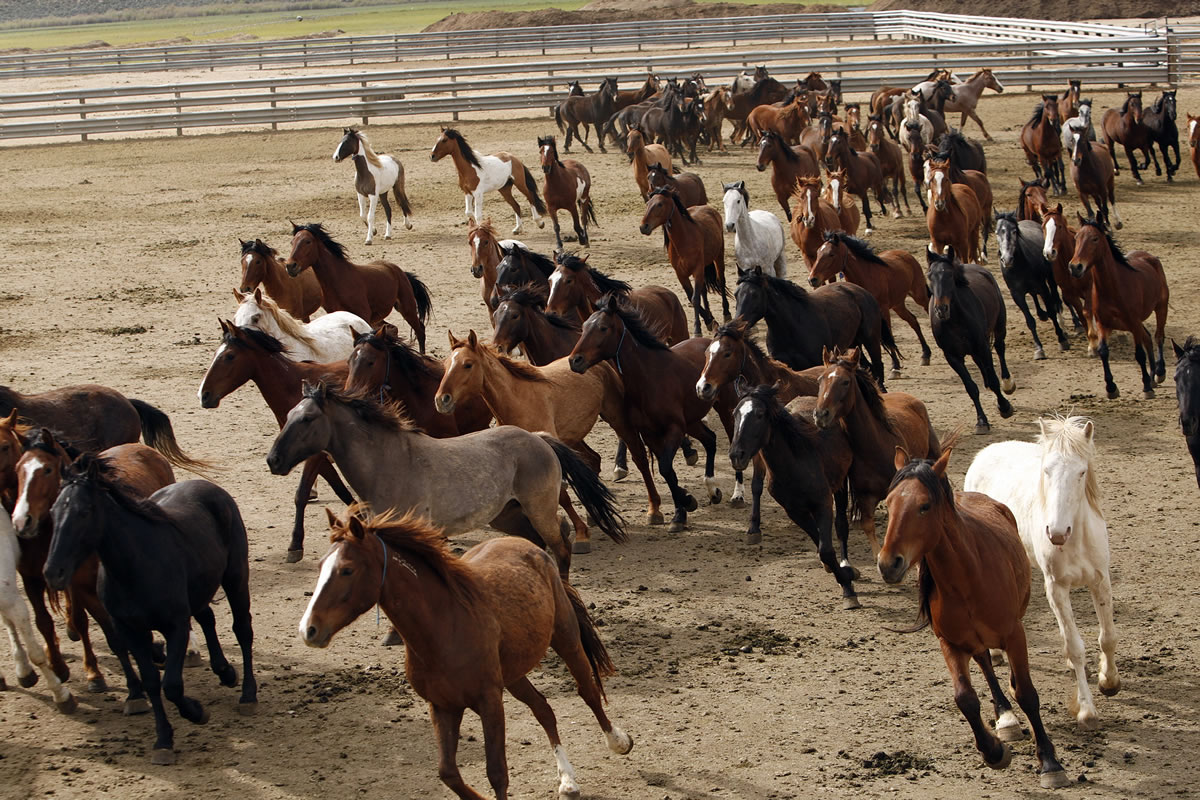RENO, Nev. — A scathing independent scientific review of wild horse roundups in the West concludes the U.S. government would be better off investing in widespread fertility control of the mustangs and let nature cull any excess herds instead of spending millions to house them in overflowing holding pens.
A 14-member panel assembled by the National Science Academy’s National Research Council, at the request of the Bureau of Land Management, concluded BLM’s removal of nearly 100,000 horses from the Western range over the past decade is probably having the opposite effect of its intention to ease ecological damage and reduce overpopulated herds.
By stepping in prematurely when food and water supplies remain adequate, and with most natural predators long gone, the land management agency is producing artificial conditions that ultimately serve to perpetuate population growth, the committee said Wednesday in a 451-page report recommending more emphasis on the use of contraceptives and other methods of fertility control.
The research panel sympathized with BLM’s struggle to find middle ground between horse advocates and ranchers who see the animals as unwelcome competitors for forage. It noted there’s “little if any public support” for allowing harm to come to either the horses or the rangeland itself.
The report says the current method may work in the short term, but results in continually high population growth, exacerbating the long-term problem.
“Addressing the problem immediately with a long-term view is probably a more affordable option than continuing to remove horses to long-term holding facilities,” the report said.
It drew quick response from various interest groups that have promoted everything from a moratorium on all horse roundups to legalizing the sale of gathered mustangs for slaughter.
“This is a turning point for the decades-long fight to protect America’s mustangs,” said Neda DeMayo, president of Return to Freedom, one of more than 50 advocacy groups in the American Wild Horse Preservation Campaign.
“The report delivers a strong case for an immediate halt to the roundup and removal of wild horse from the range, an increase in wild horse and population levels and implementation of in-the-wild management using available fertility control options,” said Suzanne Roy, the coalition’s director.
The conflict has raged for decades but has intensified in recent years for cash-strapped federal land managers with skyrocketing bills for food and corrals and no room for incoming animals.
BLM officials said they welcomed the recommendations in their effort to make the program more cost-effective but had no immediate reaction to the criticisms.
“Our agency is committed to protecting and managing these iconic animals for current and future generations,” Deputy Director Neil Kornze said.
“The business as usual practices are not going to be effective without additional resources,” said Guy Palmer, a pathologist from Washington State University who chaired the research committee.
Compounding the problem is a horse census system and rangeland assessment practice rife with inconsistencies and poor documentation, the committee said, noting a previous NRC committee charged with the same task reached the same conclusion 30 years ago.
Panel members said they found little scientific basis for establishing what BLM considers to be appropriate, ecologically based caps on horse numbers and even less basis for estimating the overall population itself.
“It seems that the national statistics are the product of hundreds of subjective, probably independent, judgments and assumptions by range managers and administrators,” the report said.
BLM’s current population estimate likely is anywhere from 10 percent to 50 percent short of the true level, the report said.
The questions about the estimates come after a BLM report said the number of animals at holding facilities surpassed the estimated number on the range in 10 Western states earlier this year for the first time since President Richard Nixon signed the Free-Roaming Horses and Burros Act of 1971.
The agency averaged removing 8,000 horses from the range annually from 2002 to 2011. Last year, it spent 60 percent of its wild horse budget on holding facilities alone, more than $40 million, the committee said.
Palmer said the public traditionally adopted about 3,000 of the horses annually but that has fallen off in recent years.
“The goal would be to manage horses better on the range so that any numbers that would be taken off would be matched with the adoption demand, which is not the current case. The number taken off far exceeds the adoption demand.”



